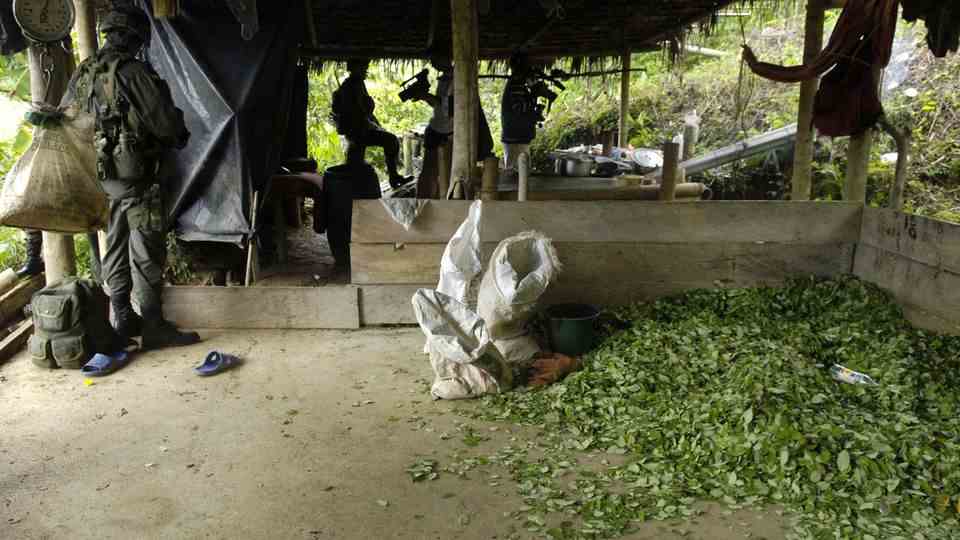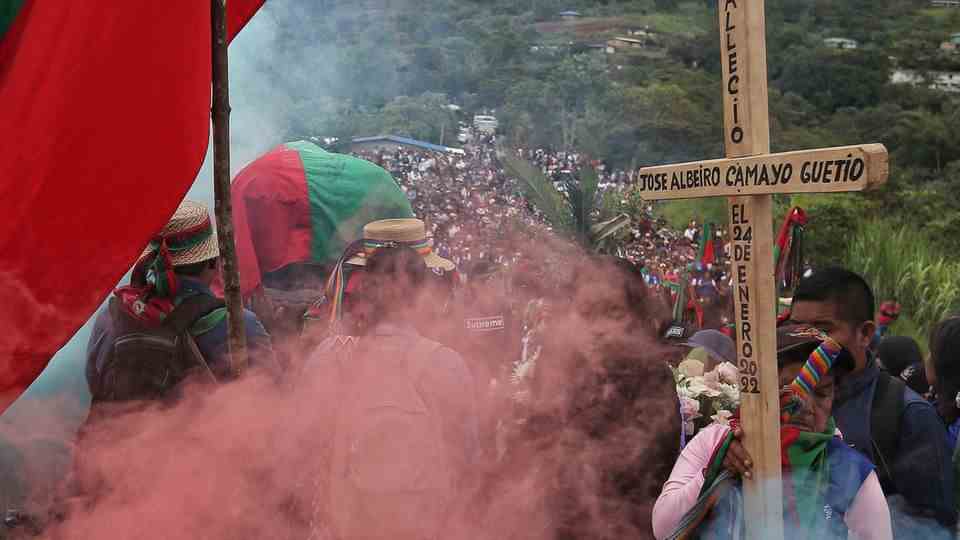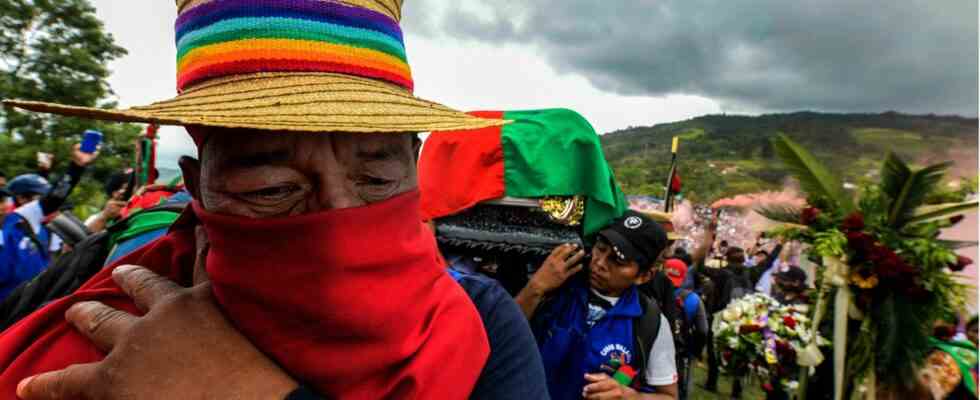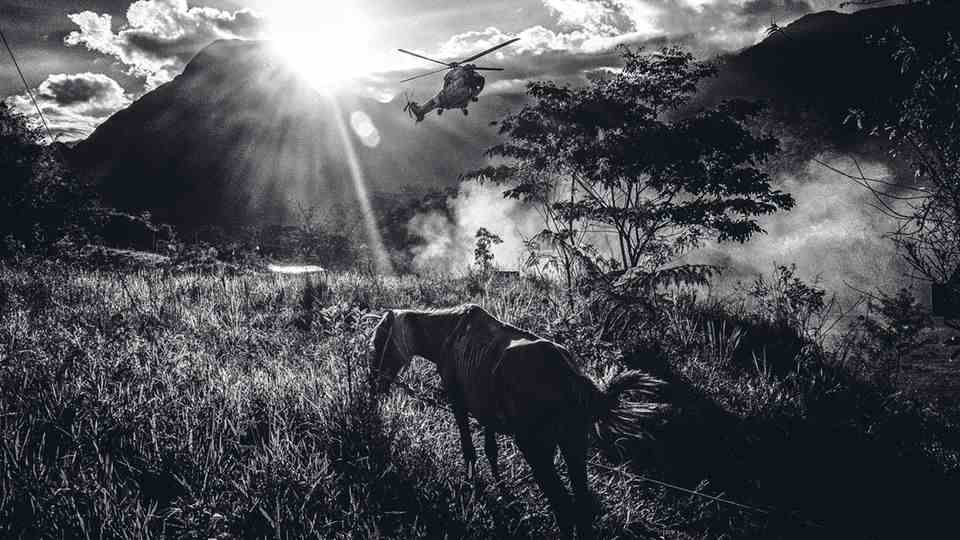Between the lines
Natives of Colombia defend their land – and pay with their lives
Funeral of an indigenous leader. The indigenous peoples of Colombia live under constant threat.
© Luis Carlos Ayala / Picture Alliance
In Colombia, the indigenous people’s territories are used for drug cultivation. Those who resist it often have to pay with their lives.
In Germany, the “Fridays for Future” demos are a familiar sight. Thousands of young people regularly take to the streets to campaign for climate protection and a sustainable future. On the other hand, those who stand up for nature in Colombia risk their lives. Especially when it comes to the territories of indigenous peoples.
Because their land is highly competitive. According to the Global Partnership on Drug Policy and Development, more than two-thirds of the coca crop is grown in protected areas and special administrative regions for Afro-Colombian and indigenous peoples. The South American state produced a total of 1,200 tons of cocaine in 2020. This emerges from a report by the United Nations Office on Drugs and Crime, which was reported by the “Schweizer Rundfunk”, among others.
Fight for new drug cultivation areas in Colombia
A lucrative business where not only drug cartels make money. Left-wing guerrilla fighters and right-wing paramilitaries are also involved in the drug trade. All these armed groups are fighting for new territory for coca cultivation. The remote regions of the indigenous peoples are particularly popular.

One of many cocaine labs in Colombia.
© Abaca Motte Jules 125105 / Picture Alliance
One of the leaders of the Wounaan ethnic group told a meeting of the Truth Commission and the National Indigenous Organization of Colombia (ONIC) that the armed forces “are threatening and killing the communities, resulting in a massive displacement into the city, leaving them in the area be able to rest and work”. The natives are exposed to constant terror and get caught between the fronts.
Indigenous people live in poverty
The indigenous groups have two options: either they bend to the cultivation of the coca plants, with which they can even make a profit, or they defend their land and risk their lives in the process. The decision usually falls on the first option.
The ethnic minorities are considered to be economically, politically and socially excluded. There is a lack of infrastructure in their areas and therefore also of access to legal markets. The majority of indigenous peoples live in poverty. The cultivation and sale of coca leaves is the only source of income for many of them. The rest of the population of Colombia and even the government often treat the natives with rejection and racism.
Shots fired during protests in Colombia
This became clear, for example, during the wave of protests last year, when tens of thousands of Colombians demonstrated against the policies of right-wing President Iván Duque. To take part in the rallies, a coalition of several indigenous peoples moved together to the city of Cali. The other protesters reacted hostile to their presence. At the time, the “Deutsche Welle” reported attacks and shots at the natives. Finally, President Iván called on them to return to their territories to avoid further “unnecessary confrontations”.

The wave of anti-government protests also drew indigenous peoples to the city.
© Andres Gonzalez / Picture Alliance
The ethnic groups are confronted with prejudices from all sides. “Many people tell us that we belong to the guerrillas, the guerrillas tell us that we are agents of the state. They don’t want to understand that we are on our own,” said Fabian Mulcue, a member of the indigenous police force of Deutsche Welle.
Drug cultivation has harmful consequences for nature and health
Drug cultivation is the main reason for deforestation in the Colombian rainforest. Processing the plants into cocaine releases harmful chemicals that leach into soil and rivers, posing a health threat. Not all ethnic groups want to put up with that. But those indigenous people who want to protect their culture and their country often have to pay for it with their lives.
The organization of the “Indigenous Guardians” put up resistance. The members take care of nature and control access to their territory. For the drug cartels, paramilitaries and guerrillas, the activists are disruptive factors that are eliminated without hesitation. This is shown by the case of 14-year-old Breiner David Cucuñame, whom ZDF recently mentioned in a post. The Regional Indigenous Council of Causca blames the FARC guerrillas for the boy’s murder. The 14-year-old will be remembered as “a protector of mother earth, a guardian of territory, a youthful protector of life.” But even those who do not offer active resistance often fear for their lives.
“A Life of Fear”
According to ONIC, a total of 68 indigenous peoples in Colombia are at risk of physical and cultural extinction due to armed conflicts and the exploitation of natural resources in their respective territories. According to the NGO Indepaz, at least 300 indigenous leaders have been killed since November 2016.

A funeral procession following the death of an indigenous leader.
© Andres Gonzalez / Picture Alliance
“It’s a life of fear within our territory,” said Miguel Pertiaga, the legal representative of the Association of Indigenous Councils Eperara Siapidara of Nariño (ACIESNA) at the Truth Commission’s meeting with ONIC. We are tired of having to endure all the abuse. But at the moment the only way out of the threatening situation is to flee.
Swell: German wave, Global Partnership for Drug Policy and Development, indepaz, Progressive International, Editorial network Germany, Swiss radio, ZDF




